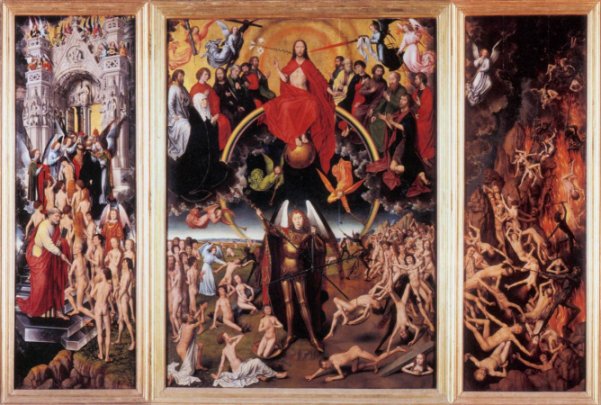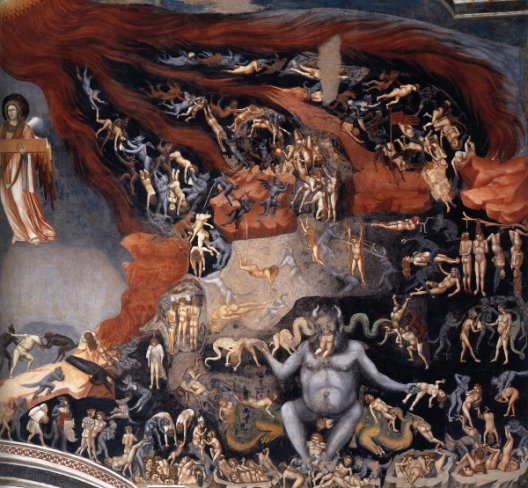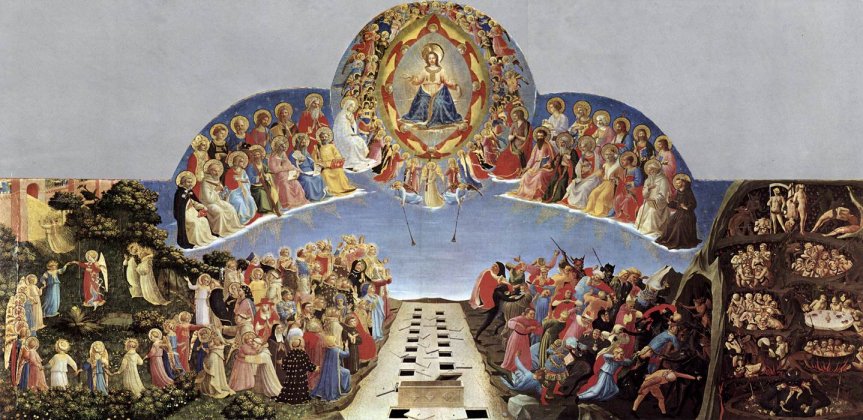|
The images in Last Judgment art are
based on the Gospel of Matthew, and the book of Revelation:
'When the Son of Man comes in his glory,
and all the angels with him, then he will sit on the throne of his
glory. All the nations will be gathered before him, and he will separate
people one from another as a shepherd separates the sheep from the
goats, and he will put the sheep at his right hand and the goats at the
left. Then the king will say to those at his right hand, ‘Come, you that
are blessed by my Father, inherit the kingdom prepared for you from the
foundation of the world; for I was hungry and you gave me food, I was
thirsty and you gave me something to drink, I was a stranger and you
welcomed me, I was naked and you gave me clothing, I was sick and you
took care of me, I was in prison and you visited me.’ (Matthew ch
25:v31–36)
After this I looked, and, behold, a door was opened in
heaven: and the first voice which I heard was as it were of a trumpet
talking with me; which said, Come up hither, and I will shew thee things
which must be hereafter. And immediately I was in the spirit: and,
behold, a throne was set in heaven, and one sat on the throne. And he
that sat was to look upon like a jasper and a sardine stone: and there
was a rainbow round about the throne, in sight like unto an emerald. And
round about the throne were four and twenty seats: and upon the seats I
saw four and twenty elders sitting, clothed in white raiment; and they
had on their heads crowns of gold. And out of the throne proceeded
lightnings and thunderings and voices: and there were seven lamps of
fire burning before the throne, which are the seven Spirits of God.
(Revelation ch 4 v1 - 5)
'Then I saw a great white throne and him who was
seated on it. From his presence earth and sky fled away, and no place
was found for them. And I saw the dead, great and small, standing before
the throne, and books were opened. Then another book was opened, which
is the book of life. And the dead were judged by what was written in the
books, according to what they had done.' (Revelation ch 20:11–12)
The last judgment is a familiar scene in art. It
often features in medieval churches, usually on the west wall or over the
doorway, as a warning to the congregation. As I have mentioned
elsewhere, hellish scenes no longer have the desired effect , often
looking comic rather than terrifying to a modern audience.
Van
der Weyden's polyptych shows most of the key elements of Last Judgment
images. At the bottom, dead souls, reunited with their bodies, are
emerging from the ground. Christ is seated on a rainbow as mentioned in
Revelation. To the left (Christ's right) the saved are
being ushered through a grand gothic gateway. To Christ's left the
damned are on their way to Hell. On either side of Christ are various
figures: apostles, saints, popes, bishops, kings. The Virgin and John
the Baptist are interceding on behalf of souls. Above - an unusual
feature in Last Judgement images - angels are carrying the instruments of
the passion.
Here's a larger version of the centre section. Next
to Christ are symbols of salvation, a lily, and damnation, a flaming
sword. Below Him, Archangel Michael is weighing souls with his scales.
Although Michael is mentioned in Revelation when he defeats Satan
(Bk 12 v 7-9) the tradition of him weighing souls does not come
from scripture, and it is suggested that the idea comes from a much
earlier, pre-Christian tradition, perhaps that of Horus and Anubis
from the Egyptian book of the Dead. The trumpeting angels on either side
of Michael do have Biblical authority. Revelation chapter 8
describes the effects of the sound of the trumpets of the seven angels,
and extraordinarily vivid passage. Van der Weyden only has room for four
of the angels. Gabriel is sometimes associated with this
tradition.

|
Why a
rainbow?
The rainbow appears in Genesis, once the
flood is over, and is God's symbol of the covenant between him and
all living things:
And God said, this is the token of the covenant
which I make between me and you and every living creature that is
with you, for perpetual generations: I do set my bow in the cloud,
and it shall be for a token of a covenant between me and the earth.
And it shall come to pass, when I bring a cloud over the earth, that
the bow shall be seen in the cloud: And I will remember my covenant,
which is between me and you and every living creature of all flesh;
and the waters shall no more become a flood to destroy all flesh.
And the bow shall be in the cloud; and I will look upon it, that I
may remember the everlasting covenant between God and every living
creature of all flesh that is upon the earth.
(ch 9 v 12 – 16)
Scholars may argue whether the
rainbow in Revelation is a direct reference to Genesis, but it is
certainly an appropriate one. In Genesis life on Earth starts again:
in the Last Judgment humanity rises from the dead.
Some more images.
The last judgement narrative is particularly suited to the tryptych
format, as in Han's Memling's version. Was he aware of Van der
Weyden's polyptych? There are many correspondences.

Muzeum Narodowe, Gdansk
Giotto's west wall of the Scrovegni
chapel is a very graphic version, particularly on the side of the
damned.
|





